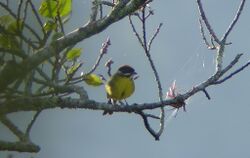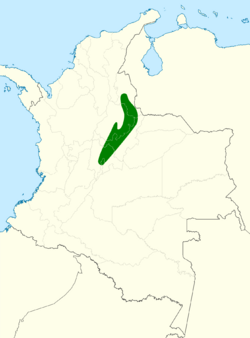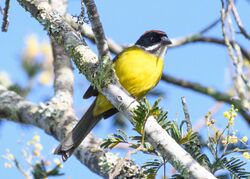Biology:Moustached brushfinch
| Moustached brushfinch | |
|---|---|

| |
| Scientific classification | |
| Domain: | Eukaryota |
| Kingdom: | Animalia |
| Phylum: | Chordata |
| Class: | Aves |
| Order: | Passeriformes |
| Family: | Passerellidae |
| Genus: | Atlapetes |
| Species: | A. albofrenatus
|
| Binomial name | |
| Atlapetes albofrenatus (Boissonneau, 1840)
| |

| |
The moustached brushfinch (Atlapetes albofrenatus) is a species of bird in the family Passerellidae.
It is found in northern Colombia, where its natural habitats are subtropical or tropical moist montane forest and heavily degraded former forest.
Taxonomy and systematics
The moustached brushfinch was first formally described in 1940 by the French ornithologist Auguste Boissonneau. He named it Tanagra (arremon) albo-frenatus, considering it to be part of the Tanager family.[2]
The International Ornithological Congress and the Handbook of the Birds of the World consider the moustached brushfinch to be monotypic - i.e. having no subspecies. The eBird/Clements and Howard and Moore checklists include the Merida brushfinch - A. albofrenatus meridaeas - as a subspecies of the moustached brushfinch.[3][4]
A recent study of the mitochondrial DNA gene sequences for the family Passerellidae indicates that the moustached brushfinch is most closely related to the Ochre-breasted brushfinch, found in Colombia and Venezuela, and the Santa Marta brushfinch, endemic to Colombia.[5]
Description
Like most Atlapetes species, the moustached brushfinch is a large-headed, long-tailed New World sparrow.
Adult. Adults are between 17.5 and 18cm in length, and weigh approximately 30g. Their upper parts are mostly olive green, with the primaries and tail being black tinged with olive. The breast, belly and vent are deep yellow, while the flanks are yellow with a greenish wash.
The species has a striking head pattern, with a bright chestnut-rufous cap and nape, black forehead, and an all black mask extending from the lores to the nape. The throat and malar stripes are white, separated by black submalars. In some poses the white malar stripe can be seen to extend almost to the nape.[6][7][8][9]
The bill is black, the irises are red or reddish brown, and the tarsi and toes are brownish grey or pinkish grey.[7]
Juvenile. Brownish olive above, dusky olive yellowish below with faint streaking. The moustachial area is dull yellow with a weakly formed malar stripe. The mask and sides of the head are duller blackish or dusky, and the crown is olive to brownish olive (not chestnut).[7]
Similar species. The plumage of the merida brushfinch of Venezuela is distinguished from that of the moustached brushfinch by its yellow throat, a lighter crown described as cinnamon-rufous, a broader white malar stripe with a narrow black submalar, and a much narrower area of black on the forehead.[7][9][10]
Distribution and habitat
The moustached brushfinch is endemic to Colombia’s Eastern Andes. Its range extends from just south of Bogotá to Santander. It appears to be localized in several disjunct areas rather than being widely distributed within the overall range. It is a species of the upper tropical and subtropical zones, and thus typically occurs between 1400 and 2500m in altitude, although it has been seen as low as 1000m. The species is resident (i.e. non-migratory).
The species inhabits the borders, undergrowth and midstory of thick subtropical cloud, elfin, and oak-dominated forests, as well as tangles of dry, thorny, scrubby brush. It is tolerant of disturbed habitat, and can be found in dense foliage on the borders of regenerating secondary forest.[8][7][10][9][6]
Behaviour and ecology
Behaviour. Moustached brushfinches normally move around quickly inside dense tangles of brush, with occasional visits to more exposed positions. They have been observed foraging, mainly close to the ground (<10m), as single birds, in pairs, and in what appear to be small family groups.[10]
Diet. Insects, seeds and fruit.[7]
Breeding. The breeding behaviour of the species has not been studied. The only relevant observation that has been recorded is that of an immature bird seen near Soatá in January, suggesting that breeding takes place in the December/January period.[11]
Status
The IUCN rates the species as Least Concern. No studies have been conducted the size of the population, but in the absence of evidence of significant declines in numbers or substantial threats its population is assessed as stable. No conservation measures specific to this species are in place.[1]
References
- ↑ 1.0 1.1 BirdLife International (2016). "Atlapetes albofrenatus". IUCN Red List of Threatened Species 2016: e.T103773936A94712327. doi:10.2305/IUCN.UK.2016-3.RLTS.T103773936A94712327.en. https://www.iucnredlist.org/species/103773936/94712327. Retrieved 20 November 2021.
- ↑ Boissoneau, Auguste (1840). "Oiseaux nouveaux de Santa-Fé de Bogota". Revue Zoologique par la Société cuviérienne (Mars 1840): 68. https://www.biodiversitylibrary.org/item/48713#page/78/mode/1up. Retrieved 7 July 2021.
- ↑ Gill, F.; Donsker, D.; Rasmussen, P. (Eds.). "IOC WORLD BIRD LIST (11.1)". https://www.worldbirdnames.org/new/ioc-lists/master-list-2/.
- ↑ del Hoyo, J (Ed.) (2020). All the Birds of the World. Barcelona: Lynx Edicions. p. 779. ISBN 978-84-16728-37-4.
- ↑ Klicka, John; Barker, F. Keith; Burns, Kevin J.; Lanyon, Scott M.; Lovette, Irby J.; Chaves, Jaime A.; Bryson Jr., Robert W. (1 August 2014). "A comprehensive multilocus assessment of sparrow (Aves: Passerellidae) relationships". Molecular Phylogenetics and Evolution 77: 177–182. https://phylobiogeography.files.wordpress.com/2011/10/2014-mpe-sparrows.pdf. Retrieved 2 August 2021.
- ↑ 6.0 6.1 Hilty, Steven, L.. (2021). Birds of Colombia. Barcelona: Lynx Edicions. p. 467. ISBN 978-84-16728-24-4.
- ↑ 7.0 7.1 7.2 7.3 7.4 7.5 Jaramillo, A.; del Hoyo, J.; Collar, N.; Kirwan, G.M.. "Moustached Brushfinch (Atlapetes albofrenatus), version 1.1.". Cornell Lab of Ornithology. https://doi.org/10.2173/bow.mobfin1.02.
- ↑ 8.0 8.1 Restall, Robin; Rodner, Clemencia; Lentino, Miguel (2007). Birds of Northern South America: an Identification Guide Vol 1. New Haven: Yale University Press. p. 712. ISBN 978-0-300-10862-0.
- ↑ 9.0 9.1 9.2 "Moustached Brushfinch - eBird" (in en). Cornell Lab of Ornithology. https://ebird.org/species/mobfin1.
- ↑ 10.0 10.1 10.2 Paynter, R.A. (1978). "Biology and evolution of the avian genus Atlapetes". Bulletin of the Museum of Comparative Zoology at Harvard College 148: 337. https://www.biodiversitylibrary.org/item/25433#page/375/mode/1up. Retrieved 10 July 2021.
- ↑ Borrero H., José Ignacio; Olivares, Antonio (1955). "AVIFAUNA DE LA REGION DE SOATA DEPARTAMENTO DE BOYACA, COLOMBIA". Caldasia 7 (31): 80. https://www.jstor.org/stable/44240737. Retrieved 2 August 2021.
Wikidata ☰ Q2096798 entry
 |



